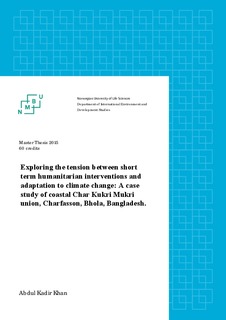Exploring the tension between short term humanitarian interventions and adaptation to climate change : a case study of coastal Char Kukri Mukri union, Char fasson, Bhola, Bangladesh
Master thesis
Permanent lenke
http://hdl.handle.net/11250/2359404Utgivelsesdato
2015-11-05Metadata
Vis full innførselSamlinger
Sammendrag
The objective of this study was to investigate the determinants of livelihood vulnerability and exploring the connections between humanitarian interventions and adaptation response to reduce climate vulnerability in Coastal Char Kukri Mukri union, Char fasson, Bhola, Bangladesh. Predominantly, Humanitarian interventions are aimed to ameliorate the human suffering with the "build back better" response. However, humanitarian actors are increasingly focusing on short term humanitarian interventions rather adaptation to climate change. In the dilemma of short-term to long-term interventions play a critical role from saving lives to the capacity building of the community. To examine the interconnections between humanitarian interventions and vulnerability, the study used a framework combining adaptation, institutions and livelihood perspectives with elements of community based adaptation (CBA). Moreover, the study employed qualitative research methods and explored through both PRA based focus group discussions and climate risk screening tools of affected livelihood resources to gain insight into the process of short-term emergency humanitarian relief to long-term adaption to climate hazards. In the dilemma of emergency relief and adaptation response, there remains a gap in the understanding of how institutions influence the transformation of short-term coping capacities to long-term adaptation among different livelihood groups. Humanitarian interventions have important implications for livelihoods, yet long-term adaptation should involve more households in the adaptation processes to reduce the vulnerability to climate hazards in the community.
Findings suggest that, short- term humanitarian interventions have important implications for livelihoods; yet long term adaptation should involve more households to enhance adaptive capacity in the study area of Char Kukri Mukri. Nevertheless, interventions should support the adaptation process beyond emergency relief on saving lives.
